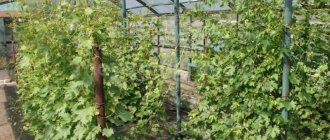Maiden grapes are translated from Greek as “virgin ivy.” This is a huge unpretentious vine that produces berries without pollination by the parthenocarpic method. There are about 10 types of virgin grapes, which differ from each other in the number of veins on the leaf (1-7) and color.
Maiden grapes are a very common way to decorate hedges, facades, fences, balconies and loggias in many cities in Russia and foreign countries. The reason for this is a number of undeniable advantages:
- beautiful appearance;
- unpretentiousness of the plant;
- creates shade in hot weather;
- protects from the wind.
Features of cultivation
In nature, this grape uses taller trees as support along which it spreads its vines. Since by nature this plant loves shade, it can be grown perfectly on balconies facing east or west. It is also possible to plant on the north side of the loggia, but only in a warm climate region and in an apartment on the upper floors. It is important that the balcony is not obscured by other structures or trees from the street.
Growing grapes on a south-facing balcony is not recommended at all, as you will have to water it abundantly every day. And this plant requires a lot of water, since the length of the grape vine can reach up to 12 m.
Girlish grapes on the balcony
Some types of wild grapes grow 4 m each year. In this regard, you need to make a support for it in advance so that the plant can weave freely. But there is one nuance here: girl’s grapes grow both up and down, so an arch would be the best option for it. If you take all this into account, then further care will not bring much trouble.
Maiden grapes need supports
Popular varieties of virgin grapes for growing on the balcony:
- Tripointed (ivy-shaped). It was bred in the Far East. It is a powerful vine with large carved leaves and blue berries. A characteristic feature is strong antennae that tightly cling to the support.
- Five-leafed came to Russia straight from the tropics, so it does not survive in all regions. It reaches a height of up to 15 m. The leaves consist of 5 oblong-shaped petals.
- Attached is a variety native to North America that grows up to 7 m. It is a small vine with rounded leaves consisting of 3 petals and yellow-gray trunk bark.
Types and varieties
There are two main varieties of wild grapes: five-leaf and tri-leaf. They can be distinguished by the shape of the leaf, which becomes clear from the name.
The first one came to us from North America. This unpretentious species is capable of producing long shoots (up to 30 m), capable of climbing up a steep surface. The leaves are palmately compound, pointed at the tips. They differ from the triacid ones in a darker shade. The fruits of the five-leaf grape are small and black. Not suitable for food!
The following varieties are widespread:
- Star Showers, also known as Variegated Leaves, is known for its marbled pattern on its leaves;
- Don Juan, striking the imagination with the purple color of the leaves in autumn;
- Hairy, with slight pubescence;
- Wall loach, easily attached to vertical surfaces.
Five-leaf grapes are grown on balconies, used as home decoration, or formed into a hedge.
The tripointed type of creeping grape came to us from the territories of Japan and China. Under natural conditions it grows among rocks, tightly entwining them. It is sensitive to cold. In areas with frosty winters, from the Moscow region to the Urals, you will have to take care of winter shelter.
The plant's vines are long, up to 40 m. They are equipped with tenacious tendrils with suckers. Densely leafy. Does not require additional supports. The leaves are rich green, turning red in autumn.
The fruits are inedible, dark, covered with a bluish coating.
Among the most common varieties are Green Spring, characterized by large leaves, and the small-leaved Vicha variety.
Tripointed grapes are also good as an hanging plant, forming hedges, and decorating balconies.
The use of creeping ornamental grapes for landscaping and beautifying a site is carried out in several ways.
Formation of a hedge. Capable of climbing on almost any surface, ornamental grapes quickly entwine wooden fences or chain-link mesh, so that in summer they are not visible under the leafy carpet. You can also use decorative grapes for zoning the area. It is worth remembering that strong vines can damage fences that are too old and dilapidated.
Forming a hedge
Vertical gardening. For beautifying various structures, buildings, arches, gazebos or canopies, wild grapes are one of the best options. Its tenacious antennae reliably attach to vertical surfaces, and its intensive growth helps cover a large area.
Vertical gardening.
Decoration of balconies and loggias. Greenery enlivens balcony partitions and adds pleasant cool shade. The grapes take root well in containers, growing and delighting with fresh foliage until autumn.
The plant is propagated by cuttings or layering. However, it is possible to grow Dame grapes from seeds. But this is a complex process that requires special skills.
The optimal time for planting is in April-May, but planting before winter, in September-October, is also quite effective.
Planting seedlings obtained by cuttings is carried out as follows:
- A hole measuring 60x60 cm is prepared. The distance between adjacent holes should not be less than 30 cm.
- Drainage is laid (crushed stone, pebbles, sand) in a layer of 20 cm.
- Peat or humus is added to the hole. This is not a necessary step; the grapes take root well in ordinary garden soil.
- The shoot is pruned, leaving 4 buds.
- The resulting cutting is placed in a hole and sprinkled with soil, burying the 2 lower buds into the soil.
- Plantings are watered and covered, protecting from the sun.
- After rooting, the protection is removed.
You can root a long vine from a mature plant. To do this, a 2-meter shoot is cut off, buried 2 cm into the soil and watered abundantly. Soon roots will appear on the nodules. After this, they can be divided into short cuttings and planted according to the above scheme.
Instructions for planting in a pot
To grow wild grapes on your balcony, you will have to purchase a large pot. Its volume should be from 100 to 120 liters, depth - at least 50 cm. Material - ceramics or wood. You need to make holes at the bottom of the pot so that water does not stagnate.
Growing grapes in a pot
There are three options for cultivating virgin grapes:
Planting with seeds is the most time-consuming process, and therefore it is used only in extreme cases. In the fall, ripe berries are collected, which are peeled from the pulp, leaving the seed. Next, they are planted in soil for seedlings to a depth of 1 cm, then watered and weeds are removed from the pot. Sprouts will appear only next year.
Growing using layering is an easier option, but it requires more space, which is not always possible on a balcony. This is done like this: a stem up to 2 m long is buried in the ground in a wave-like manner, that is, one part of the branch with a bud is buried, and the other is left above the ground.
Maiden grape seedlings
The fastest way to propagate wild grapes is from seedlings. Since the plant has good vegetative properties, there should be no problems with planting; just follow the step-by-step instructions:
- Separate the shoot from the adult plant.
- Place it in wet sand.
- Cover with a plastic cap.
- Wait for the roots to appear.
Ready-made rooted seedlings can be purchased at a specialized store. When purchasing, you should pay attention to the root system of the plant, if it is open. You should not choose shoots with weak and short roots, as they are unlikely to take root. It is best to buy grapes already planted in a pot. Although this will increase costs, it will reduce the risk of losing the plant a month after purchase.
Read also: Cool DIY snowmen
In recommendations for choosing soil for growing virgin grapes in an apartment, gardeners are unanimous about a substrate enriched with humus and humus. However, in reality the plant is not demanding and will grow in any soil in which it is planted. In nature, virgin grapes spread along leafy soil, so at home it will be the best choice.
Wild grapes are planted at home in a pot from early spring until late autumn. The prepared container can be placed directly on the floor on the balcony and filled with soil. It is advisable to place drainage at the bottom of the container.
Important! The first 2 years the grapes will trail with small thin branches. For them you need to place supports to which it will cling with the help of antennae.
Immediately after planting in the pot, the seedling should be watered abundantly. In the future, watering for an adult plant should be at least once a week. The soil must be ventilated to prevent mold from occurring. To make it easier for the plant to retain moisture in the heat, you can sprinkle the soil with tree bark.
Rules for caring for grapes on the balcony
Caring for grapes does not take much time; even a novice gardener can handle it.
Watering
The grapes are watered 1-2 times a week. The hotter it is outside, the more often the soil is moistened. For irrigation use water at room temperature. Cold liquid is one of the main reasons for the development of fungal infections, including root rot.
Water the grapes early in the morning or late in the evening when the sun is inactive. Otherwise, the plant will get burned. During the fruiting period, the amount of watering is reduced, just to prevent the soil from drying out.
Spraying
If the summer turns out to be dry, the leaves are sprayed three times a season. For this procedure, warm, settled water is used. Spraying is carried out when the sun is inactive.
Transshipments
During the first 2-3 years, the grapes are repeatedly transferred to a new pot, as soon as the root system fills the previous one. The plant is removed from the pot without destroying the earthen ball. Using a dull knife, remove the drainage and the top layer 2-3 cm thick. The root system is inspected and all damaged shoots are removed.
A layer of disinfected drainage is poured into a new pot, which is larger in volume than the previous one, then the vine is placed along with a lump of earth, the free space is filled with new fertile soil. The grapes are watered abundantly and placed in a shaded place for a week.
Transplants
After the first fruiting, transshipment is stopped, but the plant is replanted once every 2-3 years. The grapes are removed from the pot and a third of the earthen coma is removed. The roots and crown are also cut by a third, and rotten and dry shoots are removed.
Drainage and a layer of sand are poured into the new pot. The plant is installed without deepening the root collar. The free space in the container is filled with earth. After this, the grapes are watered and put in a dark place for a week. Before the first transplant, unformed fruits are completely torn off.
Feeding
Grapes grown on the balcony need additional feeding. Fertilizers are applied only to pre-watered soil according to the following scheme:
- At the beginning of March - the first fertilizing with a high content of nitrogen, necessary for the growth of green mass. The composition should include a complex of microelements.
- The second and third time fertilizers are applied in the summer with a break of a month. A mixture of nitrogen, phosphorus, potassium and microelements is added to the soil. Such products will strengthen the ovaries and young shoots.
- When the berries reach their maximum size, the grapes are fed a fourth time. The fertilizer should contain large amounts of phosphorus and potassium. It is not recommended to use nitrogen, otherwise the plant will spend energy not on ripening the berries, but on growing green mass.
- When the berries begin to ripen, do not feed at the root. Instead, the grapes are sprayed with a mixture of microelements that accelerate the ripening of the berries.
- After harvesting, fertilizers are applied for the last time for the season. These should include phosphorus, magnesium and potassium. They should not contain nitrogen.
Shaping and trimming
Grapes on the balcony are formed in the same way as in open ground. The procedure is carried out in the fall.
Every year, the most powerful and healthy ones are selected from new vines. They are divided into pairs. In each pair, one vine is cut by two-thirds, and 2-3 buds are left on the other.
The long vine will produce vines next year on which the harvest will form. The short vine will produce powerful shoots.
After the long vine yields its harvest, it is cut down to the base. Shoots grown from short vines are formed according to the described principle.
Sanitary pruning is carried out annually - removing old and diseased branches.
How to make grapes entwine a balcony? For this he will need support. If the building has a lattice or columns, the vines are allowed to climb along them. If there are none, attach ropes to the outside of the windows and use them as supports.
Preparing for winter
Grapes are left to overwinter on the balcony only if the temperature there does not drop below 0°C. In this case, the vines are removed from the supports and laid on the floor. They are covered with burlap on top and covered with peat or sawdust.
In spring the mulch is removed. The vines are being sent back up the supports.
If it’s cold on the balcony, the plant is brought into the apartment. At temperatures up to +10°C, the grapes will be at rest. If a cool place is not found, the plant’s vines are attached to a support installed at home.
The liana is watered and fed as in summer, and additional lighting is provided. Under such conditions, grapes often produce a second harvest.
Feeding and pruning
Nitroammofoska for feeding grapes
Since the girlish grapes on the balcony are deprived of a natural influx of organic and mineral substances, feeding is needed for their full development. It is this that is an important component of plant care. This is especially important during the fruiting period of the plant.
- In spring or early summer, you can add 40-50 g of nitroammophoska per 1 square meter. m.
- During active growth, the wild vineyard needs to be fed with organic fertilizers (manure, chicken droppings).
Important! The soil in the pot needs to be loosened frequently, but this should be done with extreme caution so as not to damage the roots.
Another important condition for proper care is pruning to form a bush. It can be carried out starting from the second year, removing dry leaves and young growth.
As for pests, a winegrower cannot escape from them even on the balcony. Most often, girlish grapes are affected by aphids. A solution of water and alcohol (add 100 ml per 10 liters) and ordinary laundry soap have worked well in the fight against it. The first is to spray the crown with a spray bottle, and the second is to soap the leaves, washing off the insects.
Damage to leaves by pests and diseases
For the first wintering, the grapes with the pot are brought into a warm room, cutting off the young shoots. In the future, this will simply be impossible, since wild grapes grow before our eyes, becoming unbearable. The trunk and branches of the plant can easily withstand frost, but the roots will have to be covered (with rags, straw, or a thick layer of mulch).
If you follow the tips and recommendations above, the girlish grapes on the balcony will grow in the first two years and will delight the eyes of passers-by with green foliage in summer and burgundy foliage in autumn. The main thing is not to forget the key points: abundant watering in the heat, crown-forming pruning and insulation for the winter.
Grapes on the balcony are an excellent solution for open structures that need shading. Maiden or wild grapes are used to decorate the facades of buildings, fences, hedges and, of course, balconies.
This is the kind of façade decor you can create with your own hands.
Preparing a place for a plant
Since we are talking about growing virgin grapes on a balcony or loggia, we will not touch on the agrotechnical features of its free cultivation in open ground and will immediately move on to what is required to grow a plant on the 10th or 20th floor of an apartment building.
The first thing that an amateur home gardener should take into account is how harmoniously your idea of growing grapes and indoor flowers on the balcony will fit into the overall design concept of the facade of the house in which you live. It’s one thing to realize your desires and hobbies in a limited space, when only you and your guests can admire your achievements; it’s another thing to display the results of your labors on the façade of an elite house, shining with tinted French windows, in the center of a large industrial center. In truth, your work will look like a small green patch, absurdly stuck to the facade of a beautiful house, the pride of the local administration.
Such inappropriate zeal in growing indoor plants can cause bewilderment not only among the townspeople who are forced to observe the fruits of your initiative every day, but also dissatisfaction with the local administration, which can easily fine you for excessive love for indoor flowers.
If your balcony, either in terms of the concept of the facade or its location, will not overly traumatize the psyche of fans of standardization, then - Forward! Get to work!
Considering that the girl’s grapes on the balcony are a tree, albeit in the form of a vine, it will need a considerable container for root growth and normal nutrition. At a minimum, a 100 liter barrel.
The plant is perennial and large. Unlike flowers, it is impossible to bring it in and out of your apartment for the winter. Therefore, you should initially provide not only a supply of soil with the prospect of growth, but also the possibility of insulating the container in winter. The trunk and branches can survive even a very harsh winter without much damage, but if frost touches the roots, the plant will simply die.
Tip: Arrange a container for girlish grapes on the balcony within the area of the balcony. It is desirable that the container be made of wood (larch, oak), or lined with wooden dowels.
Being a poor conductor of heat, wood will protect you from frost to some extent. Consider the possibility of additional insulation - either by simply wrapping the container with heat-insulating material, or by installing electric or water heating on frosty days. This is most easily solved on glazed balconies. But growing virgin grapes on them makes no sense.
Do not forget to arrange good drainage from expanded clay gravel or medium fraction of crushed stone (not limestone) so that the plant feels comfortable and does not experience waterlogging of the soil.
Classification
The plant belongs to the class of vines and has a length of up to 15 meters. Depending on the variety, the leaves can have different shapes and colors - from yellow to dark purple and crimson.
The two most common classes are tri-leaf and five-leaf grapes. The first is similar to ivy and is clearly recognizable by its three-lobed multi-colored leaves.
Tripointed wild grapes
The five-leaf plant pleases with its green living curtain all summer and only in the fall it acquires a bright red color. The leaves themselves have an oval, five-pointed shape.
Agricultural technology
Maidenhair grapes can be planted not only in open ground, but also in flowerpots on a balcony or loggia. In the fall, this beautiful plant will delight the eye with its last piercing scarlet colors, and in the summer it will reliably cover the balcony from the scorching rays of the sun with its thick leaves.
The flowerpots for planting it should be quite spacious, 20-30 liters or even more, since its root system is well developed and sinks deep into the ground. On a balcony, in cramped conditions, the vine will not grow as much as in open ground, but it will be enough for shade in summer and beauty in autumn.
Wild grapes themselves are not afraid of the sun, and can grow well in the very sun, protecting the space with their leaves and creating dense shade. On the north side or in partial shade, the vine will also grow, but not so quickly. In addition, in the fall its leaves may not change color to bright red. However, not all types of wild grapes have leaves that turn purple in the fall; in some species they simply turn yellow, like other plants.
The grapes are resistant to urban air pollutants - car exhaust gases, soot, smoke, and so on. This is a real find for revitalizing and greening the cityscape and gray walls of buildings.
It is better to propagate it by cuttings or seeds. Cuttings take root easily and quickly and already grow 2-3 meters in the first year. The vine grows to its full strength in the second or third year. Growing from seeds will take a little longer - they are planted in the fall, and the first shoots hatch only the following summer. It will take another year or two for them to grow and become stronger. Propagation by offsets is suitable for adult, overgrown vines with a large number of shoots; they are simply dug into the ground and then separated from the base. In open ground they are buried directly in the ground, in closed ground - in flowerpots.
You can plant cuttings in spring or summer, using material after pruning. They can be planted in any type of soil, but they will feel best in heavy, humus-rich soil with an acidity in the pH range of 5.7-7.0. Planting on alkaline soil with a pH of 7.1-8.0 is allowed.
You need to put a drainage layer on the bottom of the flowerpot, then pour a mixture of ordinary soil, sand, compost or humus.
In open ground, the vine develops a fairly powerful root system that can get moisture literally from underground. Therefore, it does not need watering; only seedlings aged 1-2 years are watered. However, in a cramped flowerpot you cannot do without watering; to retain moisture, the top layer of soil must be mulched with bark, sawdust or pine needles.
The growing shoots are attached to a support, and they beautifully hang down several meters. Their length and density are formed by autumn pruning, but young annual shoots can be cut off in the summer as necessary.
Grapes growing on the balcony must be fed in May or June with nitroammophos at the rate of 50 grams per vine. In summer they are fed with organic fertilizers.
The soil in the flowerpot needs to be changed once every year or two years; it will not be possible to completely replace it, but, as far as possible, you need to remove the depleted soil and add fresh soil.
The balcony is part of the apartment, even if it is located outside it. This is why decorating this room is important. This will speak about the neatness and hard work of the housewife. What else could be a better decoration than bright greenery and flowers? Growing various plants on the balcony is a favorite pastime for many. Today we will tell you how you can grow girlish grapes on the balcony. After reading this article, you will understand that such an activity is not difficult and not expensive.
Growing grapes
The most comfortable conditions for grapes are northern, western or eastern balconies. Remember, he does not like direct sunlight, prefers shade or partial shade.
Read also: Why plants in the tundra are stunted
Each plant should have at least 3-4 m of free space. If you have determined the place of growth, you can start planting.
- a cup for seedlings (paper, plastic or clay);
- film to protect sprouts from wind and cold;
- complex fertilizer;
- pegs to guide growth;
- rope mesh or chain-link;
- garden tools.
When purchasing seedlings, look at the root system. If the plant's roots look too small and are wrapped in plastic, avoid the purchase. There is a high probability that the grape bush will not take root at all. The price for plants in pots is slightly higher, but you will get a guarantee of survival.
In the photo - wild grape seedlings
Maiden grapes prefer soils rich in humus . Initially, it is better to plant the cuttings in small containers, and after they get stronger, “relocate” them to larger containers or open ground. The last option will be relevant for those whose balcony is on the ground floor.
Before growing a seedling, carry out kilching of cuttings, which promotes the formation of heel roots
When preparing the soil, take equal parts of mature compost, meadow sandy loam and loamy soil, and a purchased peat universal substrate. This will be the optimal soil composition for grapes.
If the pot for planting does not have drainage holes, fill the bottom with expanded clay, gravel or crushed fragments of ceramic pots. The size of the drainage backfill should be at least 5-10 cm.
Maiden grapes in boxes and pots must have a thick layer of drainage
You can also put dry knots, crushed leaves, a thin layer of manure or humus on the bottom. This layer will be quite loose due to the air cavities necessary for the free germination of plant roots.
Growing grapes on the balcony is best done in tubs with a volume of at least 100-120 liters. At your choice, it can be a wooden box or a ceramic pot with a depth of 40 cm.
Even growing in a pot requires creating a reliable support
The first two years, the grapes will trail solitary shoots with minor thin branches. To form the crown, immediately place the support. The latter is suitable for a grid of slats or a wide board with nails and tensioned wire.
When the shoots reach the edge of the support, pinch them for better branching.
Before the first wintering, young shoots are cut in half, the tub is brought to a warm place, put out in the spring and normal care is resumed. For subsequent winterings, the plant does not move, but if necessary, the root system is insulated.
Designer compositions
Under favorable conditions, maiden grapes will create an indescribably beautiful and difficult to artificially recreate microenvironment around your balcony, conducive to the growth of other hanging plants. Since the grapes themselves bloom for a short time, and the flowers cannot be called exquisite, the parasitic plant itself can be used as a frame for the growth of other climbing herbaceous plants, gifted by nature with bright and beautiful flowers.
The best choice for this would be roses that use the stems of the virgin grapes as a support and together with them stretch upward, or mountain clematis, which will ennoble and decorate the lush greenery of the virgin grapes with its delicate lilac or pink flowers. As well as other climbing plants for the balcony.
The flight of your imagination to use the shady canopy created by the maiden vine can be endless. The main advantage is that with its lush greenery it will protect many balcony bindweeds and indoor flowers from the effects of winds, direct sunlight or the vagaries of the weather.
And if the symbiosis of beautiful flowers or a fruit-bearing hanging plant with an ornamental vine turns out to be viable, then this will bring joy not only to you, but also to all those who can observe the fruits of your labors while passing along the sidewalk.
Grape propagation
Wild grapes on the balcony are propagated by layering, seeds and cuttings.
Cutting propagation method
| Reproduction method | Instructions and recommendations |
| By layering | The simplest method of propagation, however, it requires a lot of free space, which cannot always be allocated in a typical balcony. The stem (up to 2 m) is buried in the ground in a wave-like manner, leaving a section on top until the next bud. The distance in this case is reduced to 15 cm. In the spring, the rooted cuttings can be separated and replanted. |
| Seeds | This generative method takes the longest and is therefore used extremely rarely. In late autumn, seeds are obtained from the collected ripe berries, which are planted to a depth of 1 cm in a prepared nutrient substrate. The first shoots can be expected at the end of next July. |
| Cuttings | The optimal method of propagation for urban conditions. When carrying out planned spring pruning from adult branches, it is necessary to cut blanks the size of 2-3 buds. Cuttings with leaves removed are placed 2/3 in water. With the appearance of the first roots (after 1-1.5 months), the plant can be planted. |
Germinating grape seeds: preparation
Before planting grape seeds, they need to be stratified. This technique increases germination and boils down to keeping the seeds for 2–4 months at a temperature of +1…+5 °C. They are placed in a cotton bag or laid out on damp thin foam rubber and rolled up, put into plastic bags with tags and stored in the refrigerator on the bottom shelf. Occasionally the seeds should be removed and washed. To prevent mold from forming, they can be placed in a saucer with 3% hydrogen peroxide for 10 minutes. Then spread on a thick paper napkin soaked in hydrogen peroxide, fold and place in a plastic bag in the refrigerator. Cracking of the seeds is a signal of readiness for germination. They are placed on a napkin moistened with water (preferably melted water or spring water) and moved to a warm place until roots appear.
Stratification of grape seeds can be carried out in another way: mix them with calcined and moistened sand in a 1:2 ratio in a clay pot and bury it until spring to a depth of 40 cm in a dry place on the site.
Rules of care
Watering and fertilizing
Proper planting and care can turn a girl's grape into a bonsai
- Watering is carried out at least once a week. To maintain a sufficient level of humidity, it is better to cover the soil in the pot with a loose layer of pine needles or tree bark . Do not be overzealous when carrying out this work, otherwise the plant will be deprived of air exchange and mold will appear on the surface.
- Fertilizing is applied in the spring using a solution of 50 grams of nitroammophoska. During the active growing season, it is better to support the plant with organic fertilizers.
Every year, replace part of the soil in the tub with humus and manure. The procedure is best carried out in early spring.
- Don’t forget to carefully loosen the soil, giving the roots back the opportunity to “breathe.”
- In order for the grapes to form the required shape, the young plant is tied to wooden pegs installed in the soil . As the crown forms, it is necessary to pull rope supports that will allow the tendrils to fasten and climb up. In addition, do not forget to periodically trim limp and dry branches.
Read also: Free baby food up to 3 years old
Pest Control
The grapes are quite resistant to pests and diseases. Most often you have to fight such a scourge as aphids. In this situation, I recommend starting by washing the leaves with a solution of laundry soap or alcohol.
Caring for girlish grapes on the balcony
Wild grapes are not fussy and difficult to grow. It is enough to follow a few simple rules to make the plant look lush and beautiful. Lighting was mentioned above. Other important factors are watering, fertilizing and pruning.
Girl's grapes planted on the balcony should be watered at least once a week. However, excessive moisture is also not beneficial for the plant. Therefore, it is recommended to mulch the soil surface with pine needles and tree bark. The layer should not be dense to allow air to pass through, but even in this case it will prevent the soil from drying out quickly.
Rice. 7 Proper planting and care will allow you to get a lush plant
Feeding is carried out in several stages. Firstly, every spring, part of the soil is removed from the pot and replaced with humus or fertile soil.
Secondly, in the spring or early June, the plants are fed with nitrogen fertilizer, for example, nitroammophoska, which requires about fifty grams. Nitrogen fertilizers will accelerate the growth of shoots and make the foliage more lush.
Thirdly, it is worth periodically using organic fertilizers during the summer.
To make girlish grapes look beautiful on the balcony, they are cut and the direction of growth is set. To do this, the shoots are tied to supports. Pruning is also required to remove dry or weak branches.
When considering how to grow wild grapes on the balcony, people often wonder whether it is possible to cultivate table varieties in the same way. It's nice to enjoy berries grown on your own balcony. If you take proper care, this can be done. However, it is worth considering that more effort will be required, and the decorative effect of this option is less.
Summing up
On the landscaped balcony you can create a cozy place to relax
Girl's grapes on the balcony feel great in a private house or apartment, you just have to find a suitable place and a comfortable tub. Shade-loving plants and flowers can peacefully exist in the neighborhood with it: marigolds, ageratums, violas, nasturtiums, balsams, ever-flowering and tuberous begonias, choose the right company and go ahead for a suitable pot!
All I can do is offer you the video in this article and wish you good luck in balcony gardening. What is already growing on your balcony? Share your secrets with our readers.
Blog about indoor plants. All about caring for green pets in tubs.
How to choose grape seeds?
If you have tried a certain variety and really liked the taste, you can try to grow grapes directly from its seeds, collecting them after eating the berries. Such an experience has a chance of being successful, but it is still more useful to approach the matter with knowledge of some of the nuances.
– It is better to take seeds from a new harvest of new early varieties and hybrids that bear fruit in local conditions. Seedlings from imported seeds of southern varieties are unpromising in central Russia.
– Seeds of American and Amur hybrids have better germination than seeds of European varieties.
– In early varieties, unlike later ones, it is necessary to isolate the seeds from the berries immediately after color appears and sugar begins to accumulate. If the shell is hard and golden, not yet brown, the seeds have passed the stage of milky-waxy ripeness and are suitable for sowing.
Sunday, August 30, 2015
Maiden grapes in autumn, winter, summer and spring: caring for parthenocissus in an apartment
The maiden grape Parthenocissus, beautifully entwining the fences of cottages and the walls of houses, is known as an outdoor plant. But it can also be grown in an apartment. Still, caring for it differs depending on the time of year. So, vine maiden grapes
autumn, winter, summer and spring: caring for parthenocissus at home.
Keeping it in an apartment is not at all difficult. Five-leaved parthenocissus is a very unpretentious indoor plant. It can beautifully weave around sharp corners, tolerate insufficiently bright lighting and can become a picturesque green decoration for a flower stand.
| Maiden grapes |
The main thing is to remember the peculiarities of keeping this green phytofriend at home, so that it will delight you with its lush dark green foliage. We'll talk about them today.
Maiden grapes in autumn and winter
Parthenocissus liana should be kept cool during this time. The optimal temperature for such a green plant life is 12 degrees Celsius. Moderate watering is also required at this time. In fact, you only need to irrigate the plant to prevent the earthen clod from drying out completely.
This is all that such a loach needs in the autumn and winter. Otherwise, it does not require special care.
| Parthenocissus inserta |
Maiden grapes in summer and spring
During this period, the vine needs regular watering. It is necessary to irrigate the parthenocissus so that the soil is moist all the time. This plant loves feeding. However, it is better to apply fertilizer once every 21 days. This green friend will be grateful for a sufficient portion of sunlight. But it can also grow in a semi-shaded place.
In spring, the plant may need to be replanted. A purchased universal soil mixture is suitable for this loach. Also, the period from March to May is very good for breeding parthenocissus. This phyto-resident of flowerpots reproduces by apical cuttings.
The biggest advantage of such a plant is that it tolerates dry air. Although, of course, this five-leafed miracle will be grateful for periodic spraying.
So, girlish grapes can be kept in the house. Caring for this plant will not be a hassle. But how joyful it will be to watch his curly green “braids”!
Postscript. We often call plants by unusual names. Thus, we call plants of the malvaceae family hibiscus Chinese rose, and a representative of the legume family bauhinia - orchid tree. But in this case everything is in its place. Parthenocissus belongs to the grape family.
Sometimes this plant in an apartment can bloom and even bear fruit. However, the berries of the girl's grapes are inedible.
Advantages and disadvantages of virgin grapes
When considering the possibility of planting girlish grapes, you should carefully weigh the pros and cons, because, as with everything, there are some nuances here.
Latest articles about gardening
- Significant advantages include the appearance. This climbing representative of the flora has beautiful large carved leaves that form a thick, spectacular crown.
- And strong vines are able to withstand considerable weight and weave around a surface of almost any size. Wild grapes are not afraid of difficult growing conditions, neither air smoke nor pollution.
- Perfect for landscaping and covering walls and as a ground cover plant, and a hedge made of grapes will look very picturesque from summer until late autumn.
- Another important advantage is its unpretentiousness. It will grow in any light, in any soil, occupying small plots of land, and with minimal watering, as it is drought-resistant.
- It has good resistance to pests, diseases and frost. It is also considered to be long-lived, and the growth rate of virgin grapes is about 2 meters per year.
- He is not capricious in matters of fertilization and reproduction.
- A room covered with decorative grapes will be protected from overheating, dampness, and its walls will not be damaged by wind, dust and rain.
The disadvantages include the fact that in the spring it begins to turn green later than other plants and for quite a long time has the appearance of bare, tangled shoots, contrasting with the surrounding greenery.
Which varieties are best?
There are two varietal groups of grapes.
- Decorative. There are about 10 types of this grape, but ivy, attached or virginia are suitable for growing on the balcony. They can withstand frost and sudden temperature changes and are easy to care for. They reach a height of up to 10 m, have green leaves, blue-black fruits with a light ash coating.
- Fruit. There are a huge number of varieties here, but not all of them are suitable for growing in an apartment. Vigorous, unpretentious varieties with resistance to frost and disease have proven themselves well. These primarily include Isabella, Lidia and Moldova. All of them need timely and proper care, but withstand unfavorable environmental conditions well.
If you are not sure about the choice of variety, then when purchasing planting material, be sure to ask the seller whether the variety you like can be grown in an apartment.
Decorating a balcony with hedges
Making a hedge from virgin grapes is quite simple. To cope with such a task, you need to master the main stages of its implementation.
Vines will not stay on the wall. They will require special supports. And the more of them, the more securely the plant will be established. Most of the work involved in decorating a balcony consists of installing the support.
Vertical supports and vertical surfaces are useful for securing vines. Over time, girlish grapes, which can be grown in an apartment, will actively grow and entwine them.
A hedge of virgin grapes will work if the plant is planted in the right place. You can plant it both on the street and in the apartment. Such a hedge looks very beautiful on the walls of multi-story buildings. Lianas can stretch from the first floor to the very top if they are secured correctly. To obtain a natural barrier, seedlings should be planted in the ground right next to the house. If a person wants to decorate exclusively the top floor, then he needs to plant girlish grapes on the balcony. You just need to purchase containers with soil in advance in which the plant will be located.
An adult plant no longer needs supports. By this time it will have its own strong stem, which will be able to support all the vines. However, the possibility of the entire hedge falling should not be ruled out. This kind of trouble can happen for many reasons. Most often this happens due to strong winds. To prevent this problem, it is necessary to additionally secure the girl’s grapes at the highest point to which it has managed to grow.
In order for the grapes to wrap around the balcony correctly, you should install supports for it
Landing
There are different ways to grow five-leaf maiden grapes, but if you are not pressed for time, try doing it by sowing. You can sow the crop at any time, but if you do not do it in the fall, then the seeds need stratification.
Choice of time and place
Maiden grape triacum is one of the few varieties of parthenocissus that feel equally good both in a sunny area and in partial shade. But if you want the foliage to change its hue to bright purple in the fall, it is better to plant the grapes where they will get enough sun. In addition, seedlings planted on southern slopes grow faster and form larger foliage. A plant planted in a place where a strong wind blows does not feel well - then you will not experience rapid growth of the bush. It is not the best solution to plant girlish grapes near water pipes or wires. It is best to give preference to a place next to a barn or gazebo, fence or house. Wild grapes (or, as they are also called, maiden grapes) can grow on soil of any composition, but the root system develops best in loamy, neutral, slightly alkaline soil.
Step-by-step instruction
If you choose to propagate the crop by seeds, it is better to do this in the fall. The prepared seed material must be placed in pre-loosened and fertilized soil (no more than 1 cm) and watered. The cutting method is less labor-intensive.
In this case, you need to know how to cut the cuttings correctly: each one must contain at least 4 buds, while the cuttings of the virgin grapes are buried in the ground so that at least 2 buds remain above the ground. The cuttings need to be watered thoroughly and the planting site should be kept slightly moist in the future. This way you will be able to achieve strong seedlings.
Origin and agriculture of the plant
The plant known as "maiden grape" is a generic group of closely related species characterized by similar growing conditions in the wild and indistinguishable appearance when grown in a cultivated state.
It acquired its Latin name from the combination of two Greek words - “virgin” and “ivy”, associated with the similarity of the plant in appearance with ivy, and the ability to form fruits without pollination (parthenocapic). There are more than 10 species of plants differing in the number of veins in the leaf - from 1 to 7, as well as in the habitat of wild predecessors - East, Southeast Asia, or America.
The species differ somewhat from each other both in soil requirements and in their growing area.
The most common in central Russia are three- and five-awned maiden grapes, which are best adapted to our climatic conditions.
In their natural habitats, these plants, as is typical for most hanging vines, occupy the lower tier of the forest, using taller, upright growing trees as support plants. Being a moderately shade-loving plant by nature, maiden grapes, like many other indoor flowers and bindweeds, can be successfully grown on east- or west-oriented balconies, or on north-oriented ones, but under conditions of a mild climate and the location of the balcony on the upper floors of the building, so so that the balcony is not obscured by nearby buildings or trees. Growing on southern balconies can be problematic, as it will require daily abundant watering of the plant. And given the length of the vine, reaching 8-12 meters in length, and the abundance of leaves in the crown, this plant consumes a lot of water.
How to plant on loggias step by step?
Next, we will consider the planting process using the example of virgin and fruit grape varieties step by step.
Maiden
In order for maiden (wild) grapes to decorate your balcony, you need to prepare everything necessary for planting it and properly caring for it.
Pot and raw materials
For each plant, it is better to prepare an ordinary clay pot with a volume of 30 to 60 liters. But if you don’t have such a container on hand, then the usual 12 liters will do. bucket.
True, in the near future you will still have to transplant it into a large container, since grapes need a significant amount of land for normal growth.
Everyone has the right to decide for themselves what exactly to plant cuttings or seedlings, but it is best to buy only grafted seedlings in pots. Plants in plastic bags have weak roots, which are very difficult to work with and they rarely take root even with careful care.
Soil and watering
Fill the bottom of the container with crushed leaves, dry twigs, bark, and a thin layer of humus or manure. The roots will grow more freely in such a loose layer. The soil must be formed from equal parts, namely from mature compost, meadow sandy loam and loamy soil, and peat substrate.
After planting the seedlings, water the soil generously. Then water 1-2 times a week, while monitoring the soil moisture - it should always be slightly moist.
fruit
Vessel and material
Here you also decide for yourself what to plant - seedlings or cuttings, where to get it - buy or germinate it yourself. The main thing is that when planting, no stains or damage are noticeable on the roots, since most likely the vine is sick and such material is not suitable for planting. More details about seedling diseases in a separate article.
The principle of planting ordinary grapes is no different from planting them in open ground. The only difference is that you need to plant it strictly in the center of the pot, and then cover it with a jar to retain moisture. Typically, rooting takes 2-3 weeks, after which the jar can be removed.
You also need to prepare a ceramic pot or wooden box with a volume of 100-120 liters, 40-60 cm deep. Make several holes at the bottom to drain excess liquid.
Soil and irrigation
Cover the bottom with expanded clay or crushed stone. Then fill the container with enriched soil and sand in equal quantities. The optimal soil for grapes is written in a separate article.
After planting the seedling, water the soil generously. Monitor the humidity level: young grapes need to be watered approximately once a week.
Description and characteristics
Maiden grape is a genus of decorative deciduous vines of the Vinogradaceae family. Some regions of Asia and North America are considered to be their homeland. Five-leaf and three-leaf maiden grapes are used for landscaping areas. They differ only in the shape and color of the leaf plates. The shoots grow up to 15 m; in the second half of summer, inedible berries are formed, collected in clusters.
The plant has gained popularity due to its widespread use in landscape design and its beautiful appearance. Cultivated since 1662, the first varieties were bred in the USA. The liana is winter-hardy; in temperate latitudes, winter shelter is not required.
The easiest way to plant a plant is by cuttings. Planting material can be purchased at a nursery or gardening store.
When choosing, you should pay attention to the condition of the trunk - it should have several growth buds and a light brown bark color. It is recommended to buy seedlings in containers, as they adapt faster to a new location
Planting into open ground is carried out from the second ten days of April, when the air warms up to a stable warm temperature.
Location requirements
Maiden grapes are unpretentious to the composition and quality of the soil. It can grow on almost any substrate, and after 2-3 years of development, a comfortable environment appears under the powerful crown. For planting, it is recommended to choose a bright place with moderate wind. In dark conditions, the decorativeness of the leaves decreases and the flowering period decreases
It is important to remember that the plant needs support for the vertical growth of shoots. The liana can be planted next to a building, a fence, or a special trellis with a height of 2 m or more can be installed.
Step-by-step landing algorithm
2-3 weeks before planting, the soil needs to be dug up, weeds and other plant debris must be removed. Before planting, seedlings are immersed in water with the addition of a growth stimulator (Epin or Kornevin) for 1-2 hours. It is advisable to plant girlish grapes in the first half of the day in dry and windless weather. Working technology:
- Dig holes up to 50 cm deep. Place a layer of drainage (expanded clay, perlite or coarse sand) at the bottom, and then a cushion of nutrient substrate; a mixture of humus, peat and garden soil is suitable for this.
- Place the plant in the center of the hole, straighten the root system and sprinkle with fertile soil.
- Water each cutting generously and mulch the soil in the tree trunk area with sawdust or straw.
The interval between bushes depends on the purpose of planting. For landscaping a house or fence, plants should be planted every 100-120 cm. When forming a hedge, the distance between cuttings is reduced to 50-70 cm.











